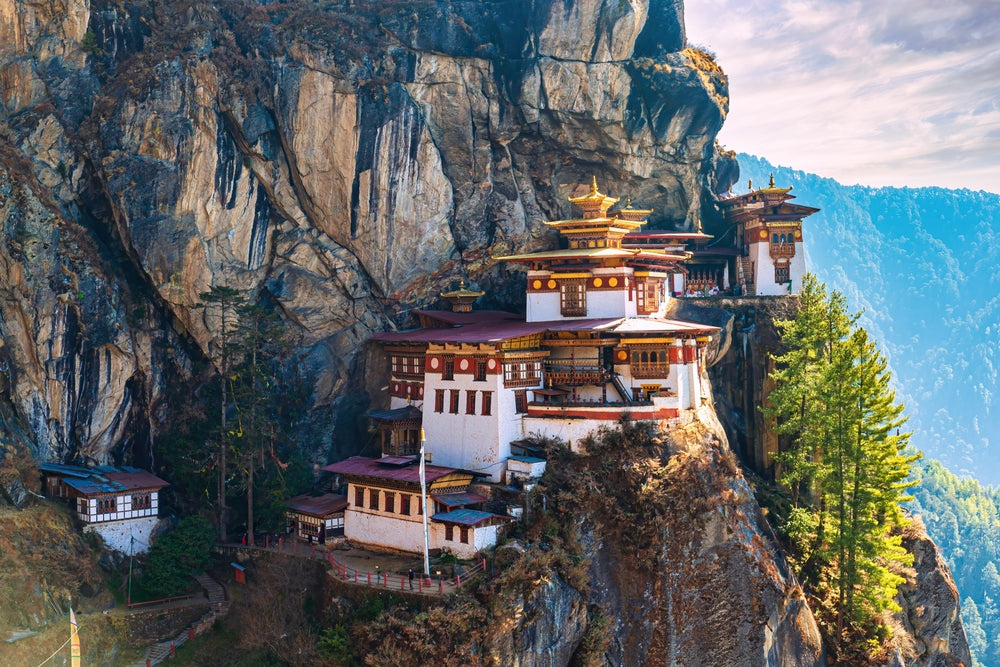
Bhutan, a Brief History
Share
Nestled high in the Eastern Himalayas, between two giants—India and China—lies the mystical kingdom of Bhutan. Known as Druk Yul, or “Land of the Thunder Dragon,” Bhutan is one of the world’s last remaining Himalayan kingdoms. With its cloud-draped monasteries, prayer-flag-strewn mountain passes, and deep spiritual roots, Bhutan feels like a world untouched by time. Behind its serene landscape lies a rich and complex history—one shaped by isolation, resilience, and an unwavering commitment to culture.

Ancient Roots and the Rise of Buddhism
Long before it was called Bhutan, the region was home to scattered clans and tribal communities who lived in relative isolation due to the area’s rugged terrain. Archaeological evidence suggests that people inhabited parts of Bhutan as early as 2000 BC. The region’s cultural foundation was truly set in motion with the arrival of Buddhism in the 7th century.
It is said that Tibetan King Songtsen Gampo built the first Buddhist temples in Bhutan—Kyichu Lhakhang in Paro and Jampa Lhakhang in Bumthang. However, the spiritual heart of Bhutan was forever changed in the 8th century when the great Indian tantric master Guru Padmasambhava (Guru Rinpoche) traveled to Bhutan. He is credited with subduing evil spirits and introducing Vajrayana Buddhism, which remains the dominant spiritual practice in the country today.

The Unifier: Zhabdrung Ngawang Namgyal
Until the 17th century, Bhutan was not a unified nation but a patchwork of warring fiefdoms and religious sects. That changed in 1616, when a Tibetan lama named Zhabdrung Ngawang Namgyal fled religious persecution in Tibet and arrived in Bhutan. More than a refugee, Zhabdrung was a visionary. He is considered the architect of modern Bhutan.
Zhabdrung unified the country under a dual system of governance—spiritual and administrative—and introduced many of the traditions, fortresses (dzongs), and laws that still define Bhutanese identity. Under his leadership, Bhutan repelled several Tibetan invasions and began to solidify its national character.

Isolation and Independence
Bhutan’s rugged geography and strong sense of self allowed it to remain fiercely independent during an era when much of the region was colonized or absorbed by empires. It maintained minimal contact with the outside world, preserving its traditions and avoiding external influence.
In the 19th and early 20th centuries, however, Bhutan’s strategic location caught the attention of the British Empire. A series of conflicts and treaties followed, including the 1910 Treaty of Punakha, which granted Britain control over Bhutan's foreign affairs in exchange for internal autonomy. This arrangement continued under India after its independence in 1947.

A Monarchy is Born
In 1907, Bhutan established its monarchy with the coronation of Ugyen Wangchuck as the first Druk Gyalpo (Dragon King). The peaceful transition from a theocratic to a monarchical system was widely accepted and marked the beginning of a new era. The Wangchuck dynasty has since guided Bhutan through modernization while fiercely protecting its culture.
Each successive king has played a pivotal role in shaping the nation—from building schools and hospitals to opening Bhutan to the outside world in the 1960s. Perhaps the most transformative decision came in the early 21st century.

Gross National Happiness and Democracy
In 2006, the fourth king, Jigme Singye Wangchuck, voluntarily abdicated the throne in favor of his son and began the transition to a democratic constitutional monarchy. This peaceful shift culminated in Bhutan’s first parliamentary elections in 2008.
Bhutan also introduced the world to a revolutionary concept: Gross National Happiness (GNH). Unlike GDP, which measures economic output, GNH considers spiritual well-being, environmental preservation, cultural integrity, and good governance. It became Bhutan’s guiding philosophy and a global example of alternative development.

A Nation Rooted in Identity
Today, Bhutan stands as a rare blend of tradition and progress. Television and the internet were only introduced in 1999, and tourism is carefully regulated to avoid cultural erosion. Visitors are drawn not just by Bhutan’s natural beauty, but by its deep sense of purpose and authenticity.
Bhutan’s story is not one of conquest or colonization. It is a tale of cultural preservation, spiritual resilience, and intentional evolution. In a fast-moving world, Bhutan reminds us that slow, steady, and sacred still has a place.

